In the evolving world of watercraft design and utility, few innovations have captured the imagination of both recreational boaters and professional workers quite like the tractor pontoon boat . This unique vessel combines the rugged dependability of agricultural machinery with the buoyant stability of a pontoon-style hull, creating a hybrid that excels in both functionality and performance on the water.
Originally conceptualized as a solution for farmers needing reliable transport across flooded fields or irrigation channels, the tractor pontoon boat has since found broader applications in industries ranging from environmental monitoring to emergency response, and even leisure activities. Its defining feature — a sturdy tractor chassis mounted atop pontoons — offers an unparalleled balance between land-based durability and aquatic adaptability.
This article explores the evolution, structure, capabilities, and diverse uses of the tractor pontoon boat , emphasizing why this innovative watercraft is becoming a staple in environments where versatility, resilience, and performance are paramount. Whether navigating shallow waters or serving as a mobile platform for heavy-duty tasks, the tractor pontoon boat stands out as a testament to engineering ingenuity and practical design.
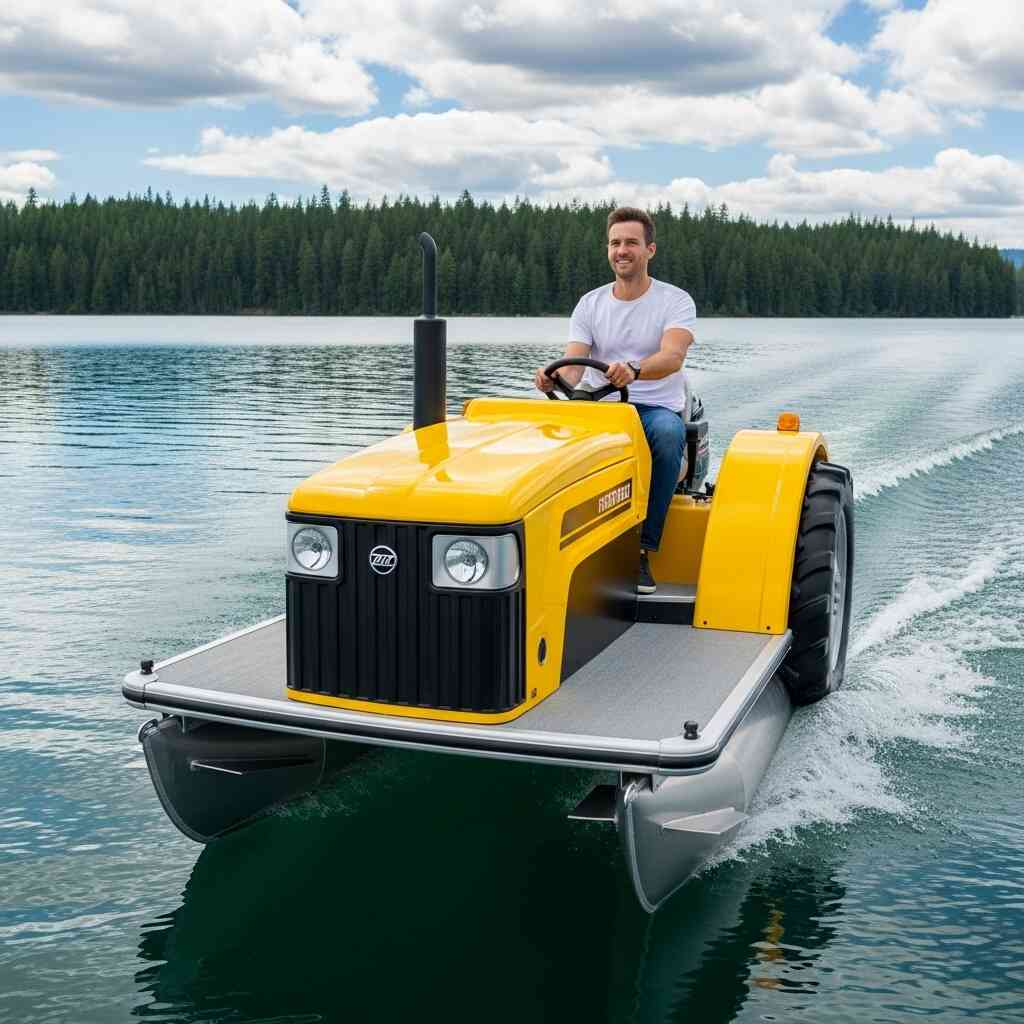
The Design and Engineering Behind the Tractor Pontoon Boat
1. A Fusion of Land and Sea Technologies
At its core, the tractor pontoon boat is a marriage of two distinct technologies: the robust mechanical systems of agricultural tractors and the buoyant, flat-bottomed design of pontoon boats. By integrating these two elements, engineers have created a vehicle that can traverse both land and water with surprising ease, depending on the model’s configuration.
The foundation of the boat typically consists of large, hollow pontoons made from high-density polyethylene or aluminum — materials chosen for their corrosion resistance and long-term durability. These pontoons provide the necessary buoyancy to support not only the weight of the tractor but also any additional equipment or cargo it may carry.
Mounted securely atop the pontoons is a modified tractor chassis, often stripped of unnecessary components to reduce weight while retaining essential powertrain elements such as the engine, transmission, and hydraulic systems. Some models are equipped with amphibious wheels or tracks that allow limited movement on soft terrain, enhancing the boat’s versatility in transitional zones like muddy shorelines or flooded fields.
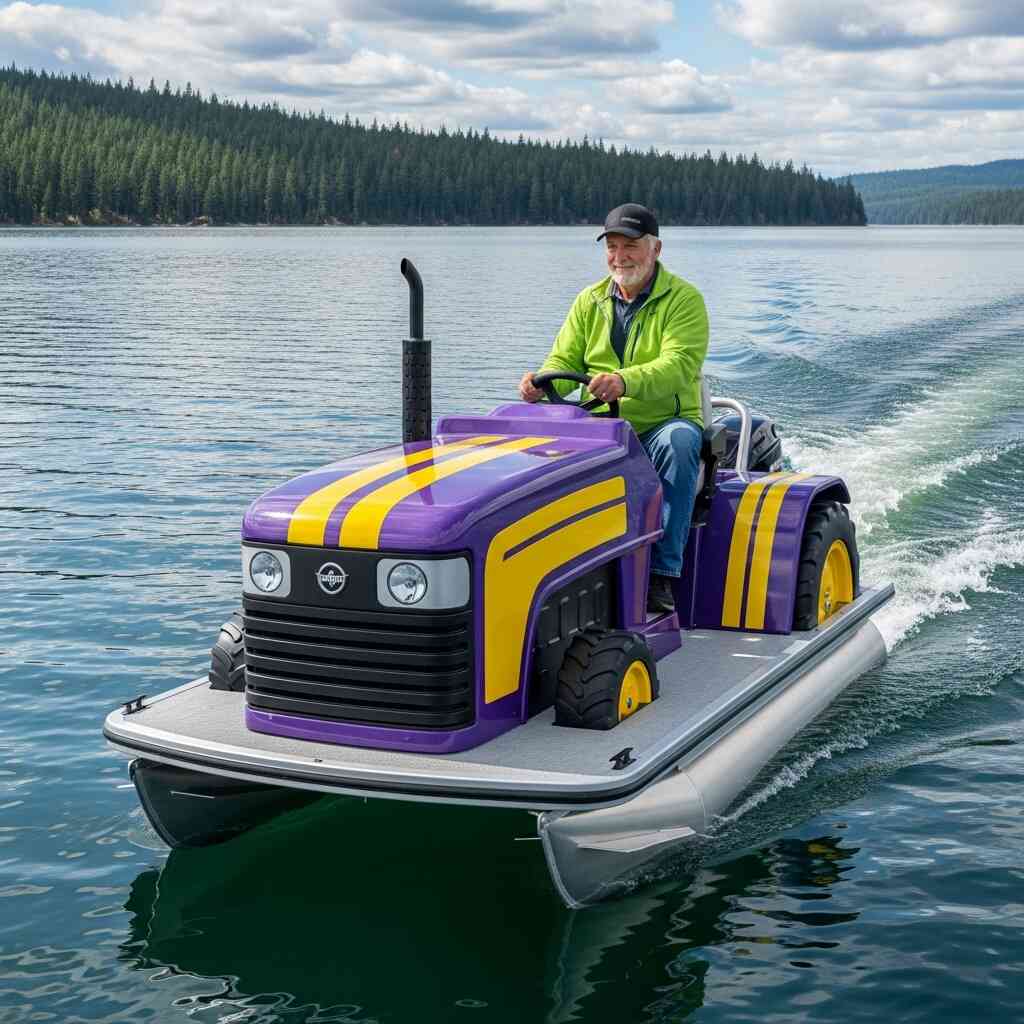
2. Stability and Safety Features
One of the most notable advantages of the tractor pontoon boat is its exceptional stability on the water. Unlike traditional V-hull boats, which rely on speed and dynamic lift to maintain balance, pontoon boats derive their stability from the wide base formed by the twin pontoons. This inherent stability makes them ideal for carrying heavy loads, operating in rough conditions, and providing a secure platform for various tasks.
Safety is further enhanced through thoughtful design elements such as non-slip decks, reinforced handrails, and watertight compartments within the pontoons. Many models include integrated lighting systems, communication tools, and emergency flotation devices to ensure safe operation in low-visibility or adverse weather conditions.
Additionally, because the tractor remains operational while on the water, operators can utilize onboard hydraulics to deploy tools, lift objects, or stabilize the boat during operations. This level of functional integration sets the tractor pontoon boat apart from other multi-environment vehicles.
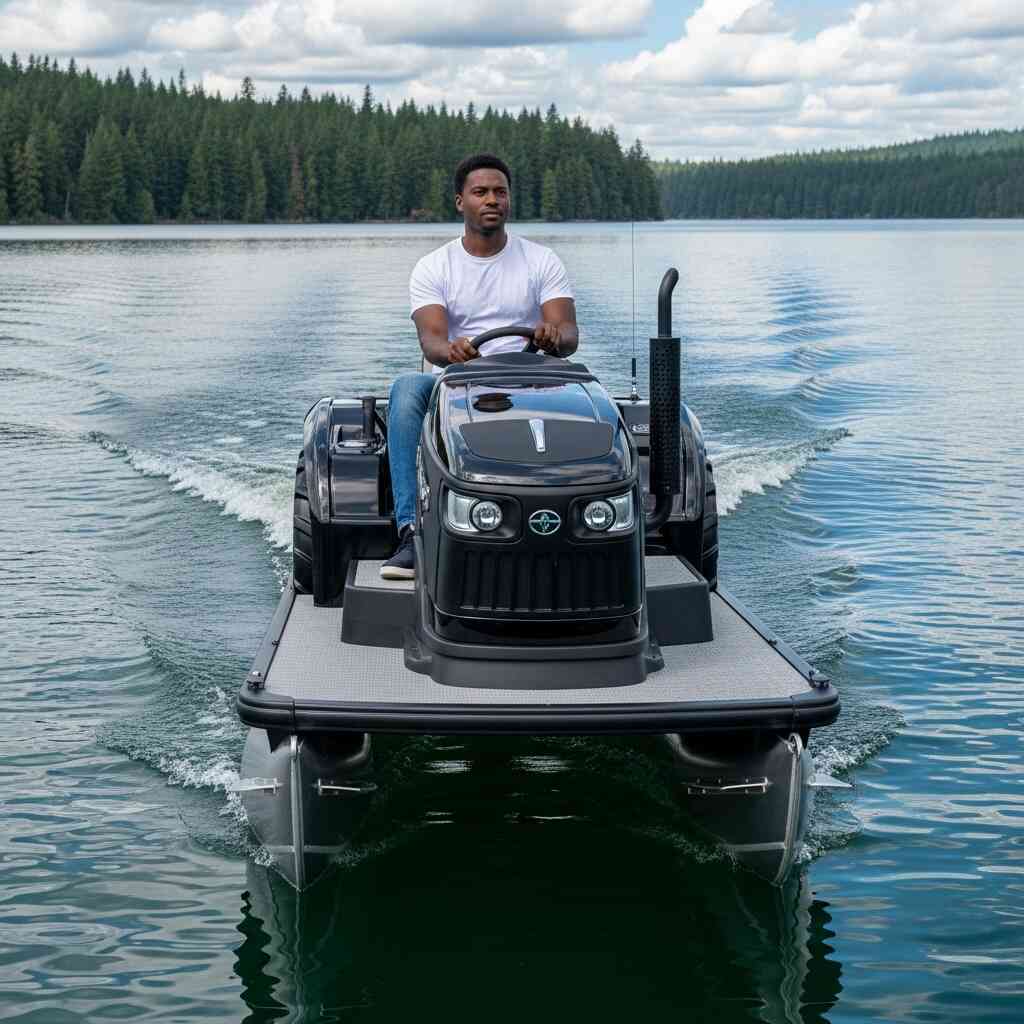
Applications and Uses Across Industries
1. Agricultural and Irrigation Management
The original intent behind the development of the tractor pontoon boat was to address a very specific need in agriculture: access to flooded fields and irrigation systems. In regions prone to seasonal flooding or with extensive rice paddies, vineyards, or aquaculture farms, conventional vehicles become unusable once the water rises.
With a tractor pontoon boat, farmers can continue maintenance work, monitor crops, and apply treatments even when fields are partially submerged. The ability to operate spraying equipment, sensors, and other attachments directly from the boat ensures that critical agricultural tasks are not interrupted by weather or water levels.
Moreover, these boats are instrumental in managing irrigation infrastructure, allowing technicians to inspect and repair dikes, sluices, and canals without draining entire systems. Their ability to navigate shallow waters and tight spaces makes them ideal for precision work in complex agricultural landscapes.

2. Environmental Monitoring and Conservation
Environmental scientists and conservationists have increasingly turned to the tractor pontoon boat as a reliable tool for conducting fieldwork in sensitive ecosystems. Wetlands, marshes, and floodplains — areas that are difficult to access using traditional boats — become accessible with this versatile craft.
Equipped with sampling instruments, GPS mapping systems, and remote sensing technology, the tractor pontoon boat allows researchers to collect data on water quality, biodiversity, and habitat changes without disturbing the surrounding environment. Its low wake and minimal draft mean it can move through delicate biomes without causing erosion or displacing wildlife.
In some cases, these boats are used to plant vegetation in restoration projects or to install artificial habitats that support aquatic life. The combination of mobility and mechanical capability makes them indispensable in ecological management efforts.
3. Emergency Response and Disaster Relief
During natural disasters such as floods, hurricanes, or dam failures, rapid access to affected areas is crucial for rescue operations and supply distribution. Traditional boats may be unable to reach certain locations due to debris-filled waters or lack of docking facilities.
Here again, the tractor pontoon boat proves invaluable. Its ability to carry heavy payloads — including food, medical supplies, and personnel — over flooded terrain enables responders to reach isolated communities. Some models are even adapted to serve as floating command centers or mobile clinics, offering temporary shelter and communication hubs in disaster zones.
Because the tractor remains fully functional, the boat can tow other vessels or assist in clearing obstructions, further aiding recovery efforts. Its durability and adaptability make it a preferred choice for organizations involved in humanitarian aid and emergency preparedness.
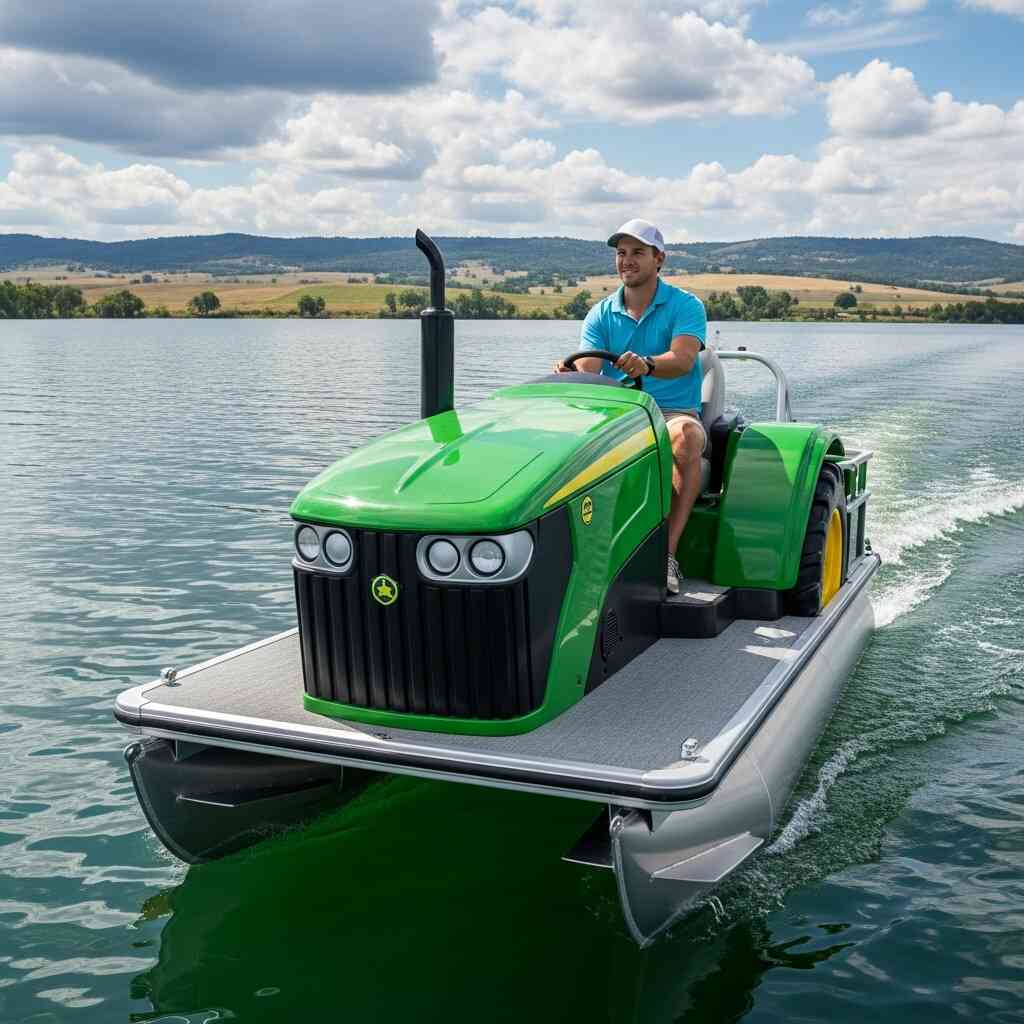
Recreational Use and Customization Potential
1. Expanding Beyond Utility
While originally designed for utilitarian purposes, the tractor pontoon boat has also begun to capture the interest of recreational enthusiasts. Boaters who enjoy exploring remote lakes, rivers, and wetlands appreciate the boat’s ability to handle shallow waters and carry camping gear, fishing equipment, or photography tools.
Custom builds have emerged that transform the basic tractor-pontoon framework into stylish, comfortable platforms for relaxation and adventure. These versions often include seating areas, shade canopies, coolers, and even small kitchens, turning what was once a purely functional machine into a floating retreat.
Some owners modify the tractor portion to run on alternative fuels or electric motors, reducing emissions and noise pollution — a consideration for those who wish to enjoy nature without disrupting it.
2. Fishing and Hunting Enthusiasts
For anglers and hunters, the tractor pontoon boat offers a stable, quiet platform from which to pursue their passions. The wide deck provides ample space for casting lines, setting up decoys, or deploying nets, while the tractor’s engine can be powered down to minimize disturbances in the water.
Its ability to remain stationary without drifting, combined with the option to mount trolling motors or solar-powered accessories, enhances the overall experience for outdoor sportsmen. Additionally, the boat’s storage capacity allows users to bring all necessary gear without overcrowding the vessel.
Hunters, particularly those pursuing waterfowl, find the tractor pontoon boat advantageous due to its ability to blend into marshy environments and approach targets silently. Camouflage paint jobs, duck blinds, and retractable blinds are among the many customization options available to enhance stealth and comfort.
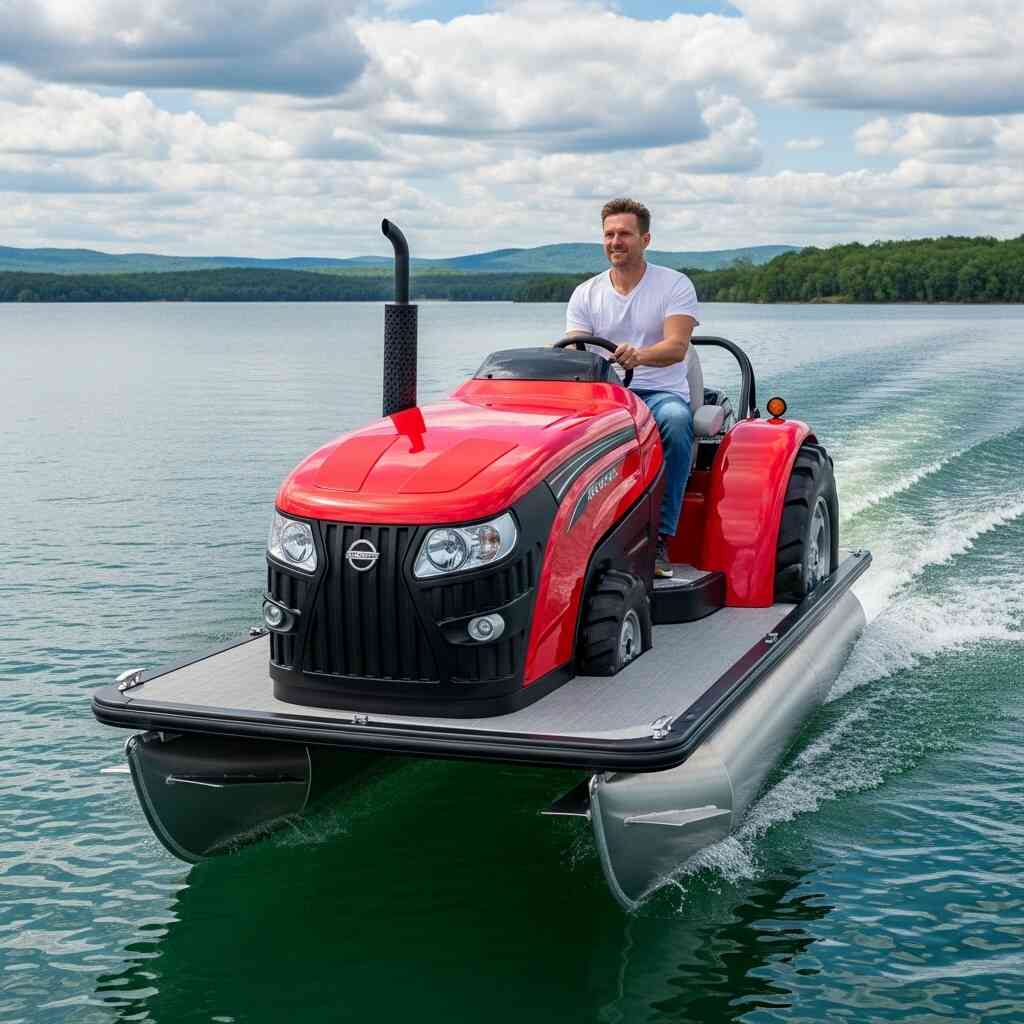
Technical Advantages and Performance Capabilities
1. Power and Propulsion Systems
The propulsion system of a tractor pontoon boat varies depending on the intended use and design philosophy. In many cases, the tractor’s engine is connected to a propeller or jet drive unit that pushes the boat forward through the water. This direct linkage ensures consistent power delivery and simplifies maintenance compared to hybrid or auxiliary motor setups.
Some models incorporate independent marine engines alongside the tractor, allowing for dual-purpose operation. This setup enables the tractor to remain idle while the boat moves, conserving fuel and reducing wear during transit. Alternatively, advanced electronic control systems can synchronize the tractor’s functions with the boat’s movement, optimizing efficiency and responsiveness.
Electric propulsion kits are also gaining popularity, especially for quieter, emission-free operation in protected waterways. These systems can be charged via solar panels or shore power, making them suitable for extended trips without refueling concerns.
2. Maneuverability and Handling
Handling a tractor pontoon boat requires a different skill set than piloting a conventional vessel. Due to its size and weight, steering is often accomplished through differential thrust (applying more power to one side) or rudder systems integrated into the pontoons. Some models use articulated steering mechanisms similar to those found in tracked vehicles, enabling tighter turns and better control in confined spaces.
Operators quickly learn that the boat’s low center of gravity and broad footprint contribute to excellent handling characteristics, even in choppy conditions. Because the pontoons absorb much of the wave impact, the ride remains smooth and steady, minimizing fatigue during long hours on the water.
Training programs and safety courses specifically tailored to tractor pontoon boat operation are becoming more common, ensuring that users understand the nuances of controlling such a specialized craft.

Maintenance, Longevity, and Environmental Considerations
1. Durability Through Smart Construction
Given its exposure to both land and water environments, the tractor pontoon boat must be built to withstand extreme conditions. High-quality construction techniques, such as double-welded seams on plastic pontoons and marine-grade coatings on metal components, significantly extend the lifespan of the vessel.
Regular maintenance includes inspecting seals, checking for corrosion, and servicing the engine and drivetrain components. Because the tractor is often the most complex part of the system, routine oil changes, filter replacements, and mechanical inspections are essential to prevent breakdowns.
Many manufacturers offer modular designs that allow for easy replacement of worn parts, reducing downtime and repair costs. This modularity also supports customization, letting users upgrade features like electronics, seating, or propulsion systems without replacing the entire boat.
2. Eco-Friendly Operation and Sustainability
As awareness of environmental issues grows, so too does the emphasis on sustainable boating practices. The tractor pontoon boat , with its ability to operate efficiently in sensitive ecosystems, aligns well with green initiatives.
By choosing low-emission engines, biodegradable lubricants, and renewable energy sources like solar panels, operators can minimize their environmental footprint. Furthermore, the boat’s shallow draft reduces disturbance to aquatic flora and fauna, preserving the integrity of fragile habitats.
Recycling old pontoons and repurposing retired tractor components also contribute to sustainability efforts. Some communities have begun developing shared-use programs, where multiple users can access a single tractor pontoon boat for various purposes, maximizing resource efficiency.
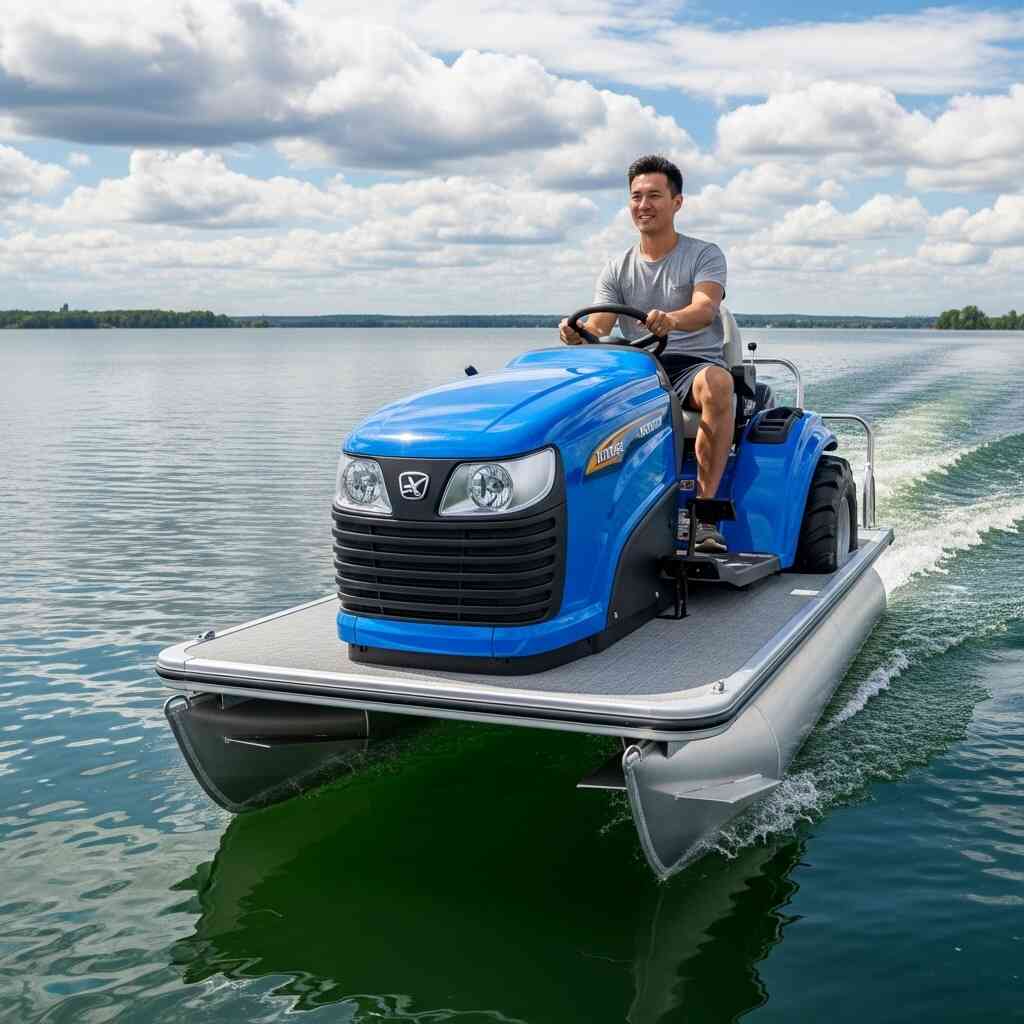
Conclusion: A Versatile Watercraft for the Modern World
The tractor pontoon boat represents a remarkable convergence of engineering disciplines, blending the strength and versatility of agricultural machinery with the buoyant stability of pontoon design. What began as a niche solution for flooded farmland has evolved into a multifunctional vessel with wide-ranging applications across agriculture, environmental science, emergency response, and recreation.
Its ability to operate in challenging environments, carry heavy loads, and perform a variety of tasks makes it an indispensable tool for professionals and enthusiasts alike. As technology continues to advance, we can expect even more sophisticated versions of the tractor pontoon boat — equipped with smarter controls, greener power systems, and greater automation — to emerge.
Whether used to maintain irrigation systems, conduct ecological research, assist in disaster relief, or simply enjoy a peaceful day on the water, the tractor pontoon boat exemplifies innovation at its finest. It is not just a means of transportation; it is a symbol of adaptability, resilience, and the enduring human desire to overcome environmental challenges through creativity and engineering excellence.
In a world increasingly shaped by climate change, rising water levels, and shifting landscapes, the tractor pontoon boat stands ready — a durable, stable, and remarkably versatile companion for both work and play.
